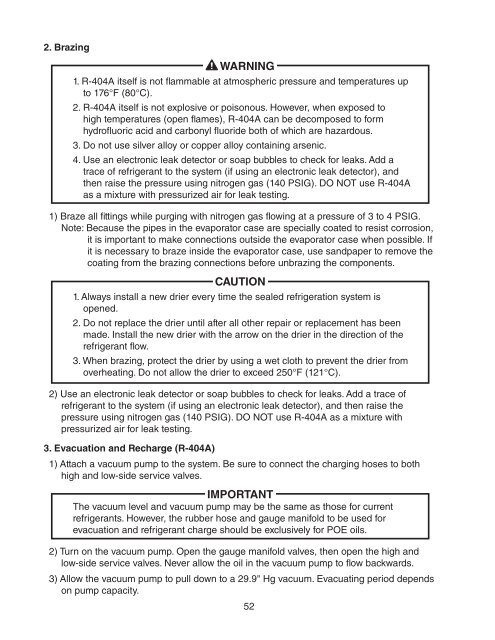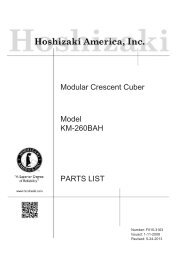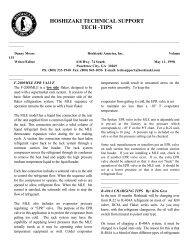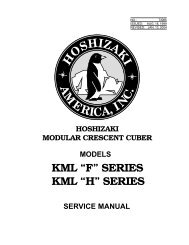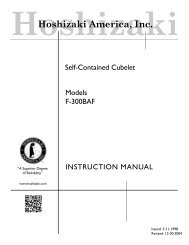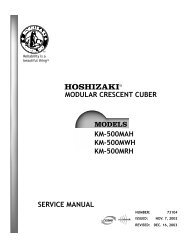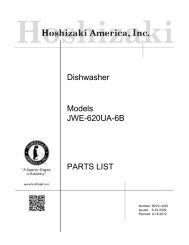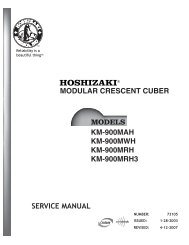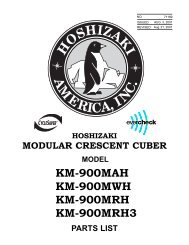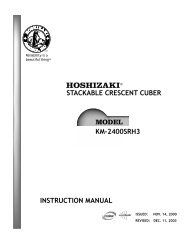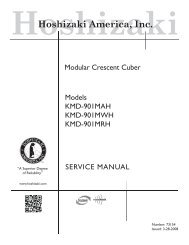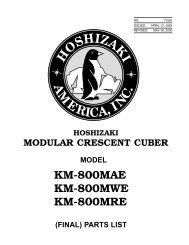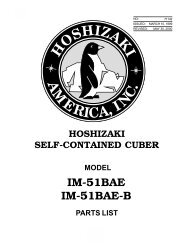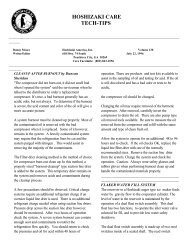KM1301SAH-E Service Manual - Hoshizaki
KM1301SAH-E Service Manual - Hoshizaki
KM1301SAH-E Service Manual - Hoshizaki
You also want an ePaper? Increase the reach of your titles
YUMPU automatically turns print PDFs into web optimized ePapers that Google loves.
2. Brazing<br />
WARNING<br />
1. R-404A itself is not flammable at atmospheric pressure and temperatures up<br />
to 176°F (80°C).<br />
2. R-404A itself is not explosive or poisonous. However, when exposed to<br />
high temperatures (open flames), R-404A can be decomposed to form<br />
hydrofluoric acid and carbonyl fluoride both of which are hazardous.<br />
3. Do not use silver alloy or copper alloy containing arsenic.<br />
4. Use an electronic leak detector or soap bubbles to check for leaks. Add a<br />
trace of refrigerant to the system (if using an electronic leak detector), and<br />
then raise the pressure using nitrogen gas (140 PSIG). DO NOT use R-404A<br />
as a mixture with pressurized air for leak testing.<br />
1) Braze all fittings while purging with nitrogen gas flowing at a pressure of 3 to 4 PSIG.<br />
Note: Because the pipes in the evaporator case are specially coated to resist corrosion,<br />
it is important to make connections outside the evaporator case when possible. If<br />
it is necessary to braze inside the evaporator case, use sandpaper to remove the<br />
coating from the brazing connections before unbrazing the components.<br />
CAUTION<br />
1. Always install a new drier every time the sealed refrigeration system is<br />
opened.<br />
2. Do not replace the drier until after all other repair or replacement has been<br />
made. Install the new drier with the arrow on the drier in the direction of the<br />
refrigerant flow.<br />
3. When brazing, protect the drier by using a wet cloth to prevent the drier from<br />
overheating. Do not allow the drier to exceed 250°F (121°C).<br />
2) Use an electronic leak detector or soap bubbles to check for leaks. Add a trace of<br />
refrigerant to the system (if using an electronic leak detector), and then raise the<br />
pressure using nitrogen gas (140 PSIG). DO NOT use R-404A as a mixture with<br />
pressurized air for leak testing.<br />
3. Evacuation and Recharge (R-404A)<br />
1) Attach a vacuum pump to the system. Be sure to connect the charging hoses to both<br />
high and low-side service valves.<br />
IMPORTANT<br />
The vacuum level and vacuum pump may be the same as those for current<br />
refrigerants. However, the rubber hose and gauge manifold to be used for<br />
evacuation and refrigerant charge should be exclusively for POE oils.<br />
2) Turn on the vacuum pump. Open the gauge manifold valves, then open the high and<br />
low-side service valves. Never allow the oil in the vacuum pump to flow backwards.<br />
3) Allow the vacuum pump to pull down to a 29.9" Hg vacuum. Evacuating period depends<br />
on pump capacity.<br />
52


